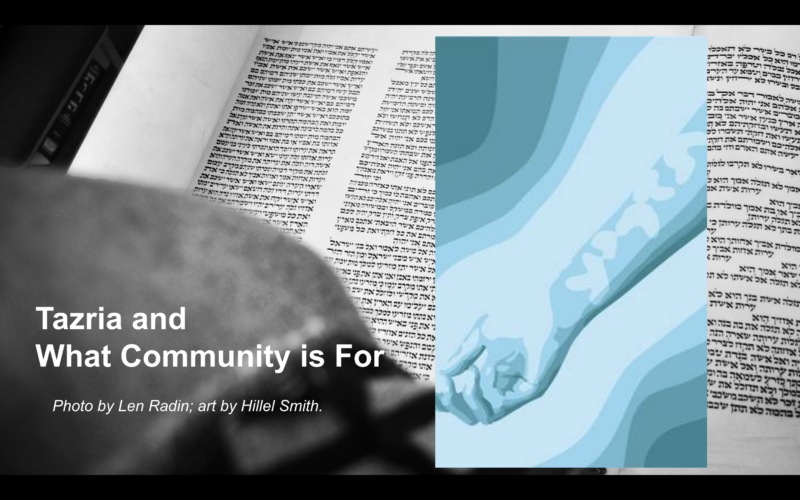
This week’s Torah portion, Tazria, speaks in detail about a condition called tzara’at.
Many translations render tzara’at as leprosy, though that’s clearly not what this is. Some other year I’ll teach about the different ways our tradition has understood tzara’at, e.g. as a spiritual sickness, or a metaphor for slander, or a punishment for racism. This year I want to talk about something else.
Torah teaches this week that a person with tzara’at is considered tamei. So is someone who’s given birth, or who’s been in contact with a dead body. A lot of translations use the language of “unclean” and “clean” for the Hebrew terms tamei and tahor, though I really don’t like that translation.
Rabbi Rachel Adler teaches that tum’ah (the state of being tamei) implies being charged-up with a kind of spiritual electricity. Something about contact with blood or birth or death makes us vibrate spiritually at a different frequency for a while. (I have written about this before.)
This isn’t about uncleanness, and it isn’t a value judgment. All of us are tahor sometimes and tamei sometimes, and being postpartum or in contact with death really is a different spiritual space. Okay. But what does this have to do with tzara’at, whatever it is, and what is this text calling us to do?
When the priest determined that someone had tzara’at, that person would be quarantined from the community for seven days. Then there was another examination. If the affliction was still there, the person was instructed to call out, “Tamei, tamei!” as they went about their business.
Reading this, I’ve often felt sorry for the m’tzora (the person with tzara’at). It isn’t bad enough that they have this condition; now they have to proclaim their situation everywhere they go?! But this year a friend pointed me toward a passage in Talmud that completely changes how I feel about this verse:
As it is taught in a baraita: It is derived from the verse: “And he will cry: Tamei, tamei” (Leviticus 13:45), that a person with tzara’at must publicize the fact that he is tamei. He must announce his pain to the masses, and the masses will pray for mercy on his behalf. And likewise, one to whom any unfortunate matter happens must announce it to the masses, and then the masses will pray for mercy on his behalf. (B.T. Chullin 78a)
The reason for calling out “Tamei, tamei!” is not to shame the person who’s afflicted. After all, as R. Adler notes, everyone is tahor sometimes and tamei sometimes. Talmud means to teach that when we are afflicted, we need to make that known to the community so the community can pray for us.
This leads to the question of what prayer is for. Do we pray in order to effect an outcome, or do we pray in order to sensitize ourselves to the needs of those around us? Both of these are legitimate Jewish theologies of prayer, though for me, the second one is the one that really resonates.
When I pray for someone’s healing, I know that my prayer may not change their medical condition. But the act of extending my heart to God on their behalf can change me. And from that changed place, I am more aware of their needs, and that’s what impels me to take action to help them.
Maybe that means checking in to see how they are. Or paying them a visit. Or providing a meal. Or wearing a mask because they’re immunocompromised. Or avoiding perfume because scents give them migraines. Or sending a note. Or even just asking if they’re okay, and really listening in response.
These aren’t the rabbi’s job. (Though I do try to do these things!) These are the responsibility of the community. This is why we we list aloud each week those for whom we pray for healing — so that the community will know that so-and-so is sick and in need of our prayers, our support, and our care.
The same is true of someone who’s grieving, or who’s lost a job, or who’s grappling with depression or mental illness, or — you name it. After all, Talmud tells us that when we are experiencing “any unfortunate matter,” we should communicate that to our community so the community can step up.
Jewishly speaking, that’s the purpose of community: to feed the hungry and comfort the mourner. To pray for each others’ well-being, and then take actions that uplift those prayers and make them real. The purpose of community is to take care of whoever’s in need. I really love that.
Returning to Torah’s teaching that someone with tzara’at is tamei: yeah, our afflictions — whether illness or another kind of suffering — can make us feel disconnected, different from everyone else. But when we can admit that we’re in that place, that’s when others can reach in and be with us where we are.
This year I’m also noticing an aural connection between the words m’tzora (a person with tzara’at) and Mitzrayim (Egypt, the Narrow Place, constriction and tsuris) In two weeks we’ll celebrate the Exodus from Egypt, Y’tziat Mitzrayim — going forth from the constriction of suffering into expansive hope.
Tazria reminds us that when we’ve got tsuris, it’s our job to let the community know so the community can pray for us — and act in ways that make those prayers real. That’s how we get to Y’tziat Mitzrayim: by taking care of each other. No one needs to be alone in suffering. No one crosses the sea alone.
This is Rabbi Rachel’s d’varling from Shabbat morning services (cross-posted to Velveteen Rabbi.) Hillel Smith’s parsha posters are available on his website.





